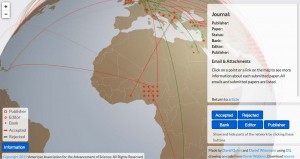Ein völliges Desaster mit allerdings beachtlichem Unterhaltungswert wurde heute auf dem Wissenschaftsolymp “Science” veröffentlicht. Um seinen sehr schlechten Eindruck von vielen open access Wissenschaftsjournals in der Pharmakologie zu bestätigen, produzierte der Science Journalist John Bohannon ein fake paper mit vermeintlich spektakulären Ergebnissen in der Krebsforschung. Die Fehler waren liebevoll und doch überdeutlich in den Text gestreut, und jeder Erstsemester sollte sie eigentlich bemerken. Trotzdem genügte der Text allen formalen Kriterien eines Papers.
The goal was to create a credible but mundane scientific paper, one with such grave errors that a competent peer reviewer should easily identify it as flawed and unpublishable. Submitting identical papers to hundreds of journals would be asking for trouble. But the papers had to be similar enough that the outcomes between journals could be comparable. So I created a scientific version of Mad Libs.
The paper took this form: Molecule X from lichen species Y inhibits the growth of cancer cell Z. To substitute for those variables, I created a database of molecules, lichens, and cancer cell lines and wrote a computer program to generate hundreds of unique papers. Other than those differences, the scientific content of each paper is identical.
The fictitious authors are affiliated with fictitious African institutions. I generated the authors, such as Ocorrafoo M. L. Cobange, by randomly permuting African first and last names harvested from online databases, and then randomly adding middle initials. For the affiliations, such as the Wassee Institute of Medicine, I randomly combined Swahili words and African names with generic institutional words and African capital cities. My hope was that using developing world authors and institutions would arouse less suspicion if a curious editor were to find nothing about them on the Internet.
Er verschickte danach dieses kleine Meisterwerk an 255 online Journals und bekam das Paper sage und schreibe 157 mal durch. Hier geht es zu der hübschen Animation aller Journals, die das Paper durchgewunken haben. Da wird sicher so mancher Editor gerade mit dem Kopf gegen die Laborwand schlagen.
Bild: Einfach anklicken und man kommt zur Weltkarte der Journals, die das Fake Paper Bohannons ackzeptiert haben. Eine Art modernes Schandmal des Verfalls eines Teils des Wissenschaftsbetriebs.
Bohannon zog nach Annahme durch ein Journal den Artikel stets zurück. Und so beendet er seinen wirklich lesenswerten Artikel mit einem der Antwortschreiben, die er daraufhin erhalten hat: ein Antwortschreiben eines Fake-Verantwortlichen eines Fake-Journals an den Fake Autor eines Fake Papers:
After a science-free review process, one of their journals—the International Journal of Cancer and Tumor—accepted the paper. Posing as lead author Alimo Atoa, I requested that it be withdrawn. I received a final message that reads like a surreal love letter from one fictional character to another:
Dear Alimo Atoa,
We fully respect your choice and withdraw your artilce.
If you are ready to publish your paper,please let me know and i will be at your service at any time.
Sincerely yours, Grace Groovy


Kommentare (14)